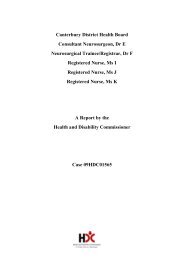Gisborne Hospital Report - Health and Disability Commissioner
Gisborne Hospital Report - Health and Disability Commissioner
Gisborne Hospital Report - Health and Disability Commissioner
Create successful ePaper yourself
Turn your PDF publications into a flip-book with our unique Google optimized e-Paper software.
<strong>Gisborne</strong> <strong>Hospital</strong> 1999 – 2000<br />
Operating Theatre Protocols<br />
2.22 Dr Lucas’ orientation programme was co-ordinated by the Charge Anaesthetic<br />
Technician. The Charge Anaesthetic Technician described Dr Lucas’<br />
orientation to theatre as follows:<br />
“On his first day he was shown all the equipment <strong>and</strong> what was<br />
available. Dr Lucas asked about the role of the anaesthetic technicians.<br />
It was explained to him that he would always have an assistant in every<br />
general anaesthetic case. [The Charge Anaesthetic Technician]<br />
explained that anaesthetic technicians were not the equivalent of nurse<br />
anaesthetists. Dr Lucas said that nurse anaesthetists do most of the work<br />
<strong>and</strong> have an overseer anaesthetist. Dr Lucas was happy that someone<br />
would be allocated to him, specifically for anaesthetics <strong>and</strong> not to be<br />
shared with the surgical side.”<br />
2.23 The Head of Department (Anaesthesia) advised that he:<br />
“spent a lot of hours going over pre-operative assessments, the lists, his<br />
core responsibilities <strong>and</strong> duties with Dr Lucas as part of [his] induction.<br />
I tried to make him feel at home. I spent time with him socially, inviting<br />
him to my home. Dr Lucas spent the whole day with the senior<br />
anaesthetic technician who showed him around the hospital, including<br />
ICU. His role in the department was explained to him <strong>and</strong> the<br />
complementary role of staff.”<br />
2.24 Dr Lucas advised that he was not aware of any theatre protocols while he was<br />
at <strong>Gisborne</strong> <strong>Hospital</strong> <strong>and</strong> he was not invited to read any theatre protocols. Dr<br />
Lucas advised that usually protocols come in a binder that is about four inches<br />
thick <strong>and</strong> he was not sure in fairness whether he would have sat down <strong>and</strong><br />
thumbed through the theatre protocol if it had been presented to him. THL<br />
stated that staff clearly recall that Dr Lucas was either given the orientation<br />
manual prior to his arrival or upon arrival.<br />
2.25 Dr Lucas advised he was given a small Department of Anaesthesia protocol<br />
binder but this mainly consisted of history <strong>and</strong> physical requirements. He was<br />
not given the orientation manual, relating specifically to THL’s processes <strong>and</strong><br />
procedures, provided to new junior doctors at <strong>Gisborne</strong> <strong>Hospital</strong>.<br />
2.26 Dr Lucas stated in his telephone interview:<br />
“No-one from Tairawhiti <strong>Health</strong>care ever discussed with me what was<br />
expected of me in the anaesthesia room. I was shown the anaesthetic<br />
equipment by the Head of Department (Anaesthesia). The machine was<br />
one I was familiar with, as were the anaesthetic agents.”<br />
2.27 Dr Lucas did not receive any formal induction in terms of Maori culture <strong>and</strong><br />
protocols. THL said the Group Manager (<strong>Hospital</strong>) referred Dr Lucas to the<br />
Maori <strong>Health</strong> Manager <strong>and</strong> also advised him to look at the Code. Dr Lucas<br />
informed me that he did know about the Maori <strong>Health</strong> Manager <strong>and</strong> sought his<br />
advice <strong>and</strong> help about Maori patients on at least two occasions. Dr Lucas said<br />
he enjoyed the enrichment of Maori culture: “I made a point of going to the<br />
72
















